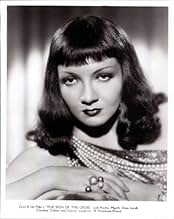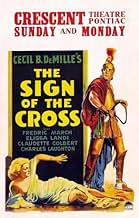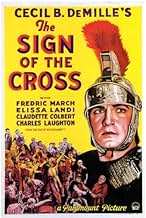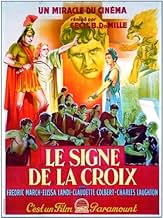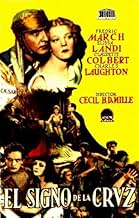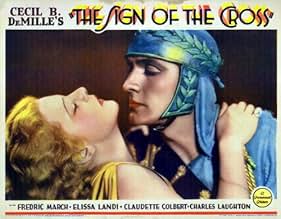IMDb-BEWERTUNG
6,8/10
2906
IHRE BEWERTUNG
Füge eine Handlung in deiner Sprache hinzuA Roman soldier becomes torn between his love for a Christian woman and his loyalty to Emperor Nero.A Roman soldier becomes torn between his love for a Christian woman and his loyalty to Emperor Nero.A Roman soldier becomes torn between his love for a Christian woman and his loyalty to Emperor Nero.
- Für 1 Oscar nominiert
- 3 Gewinne & 1 Nominierung insgesamt
Joyzelle Joyner
- Ancaria
- (as Joyzelle)
Robert Seiter
- Philodemus
- (as Robert Manning)
Empfohlene Bewertungen
Rome - First Century A. D. Nero, the mad Emperor & Poppaea, his vile Empress, engage in every sort of vice & degradation. Wanton cruelty becomes a spectator sport and virtue & innocence are denigrated. Slowly, however, a new Power is growing. People calling themselves Christians are secretly spreading their Faith ever more widely. They are horribly persecuted, but they continue to multiply. Which will eventually triumph - the might of Imperial Rome, or the gentle ones who follow THE SIGN OF THE CROSS?
This Cecil B. DeMille epic is a vivid retelling of the struggles of the first Christians. Paramount gave the film a lavish production and DeMille wrings every drop of piety & puerile interest possible from the plot. Fredric March is stalwart as the Roman official who falls in love with a beautiful Christian girl. While his ultimate conversion wouldn't convince the average modern Baptist, he holds his own in scenes with other performers whom are allowed to behave outrageously. Elissa Landi is sweet as the virtuous Believer, effectively underplaying her role.
`Do you want to play the most wicked woman in the world?' DeMille asked Claudette Colbert one day on the studio lot. She did & she does memorably, from her eye-popping milk bath scene to her revenge on her would-be lover. Sniveling, whining and wearing a huge fake nose, Charles Laughton is pure effeminate evil as Nero (notice his catamite), a foul blot on the face of humanity & stealing all his scenes from everyone else. History tells us that Nero eventually murdered Poppaea by stomping her to death...
Ian Keith is enjoyable as an unpunished villain. Ferdinand Gottshalk & Vivian Tobin are effectively degraded as Roman bacchants. Film mavens will recognize the voice of John Carradine, calling `We who are about to die, salute you!' out of the arena to Nero; he can later be spotted in the role of a Christian martyr ascending the dungeon stairs to his death.
DeMille had just returned to Paramount from a 3-year, 3-picture stint at MGM, where he was remarkably subdued. Back at his home studio he was allowed more license. Wrapping a little sermon up in a lot of sin, he filled this pre-Production Code drama with plenty of the latter. When THE SIGN OF THE CROSS was re-released in 1944, many cuts had to be made. The film now having been restored, it's not difficult to guess which sections those were. The Dance of the Naked Moon & much of the antics in the final arena sequence are beyond the bounds of good taste, but certainly not beyond the bounds of Cecil B. DeMille.
This Cecil B. DeMille epic is a vivid retelling of the struggles of the first Christians. Paramount gave the film a lavish production and DeMille wrings every drop of piety & puerile interest possible from the plot. Fredric March is stalwart as the Roman official who falls in love with a beautiful Christian girl. While his ultimate conversion wouldn't convince the average modern Baptist, he holds his own in scenes with other performers whom are allowed to behave outrageously. Elissa Landi is sweet as the virtuous Believer, effectively underplaying her role.
`Do you want to play the most wicked woman in the world?' DeMille asked Claudette Colbert one day on the studio lot. She did & she does memorably, from her eye-popping milk bath scene to her revenge on her would-be lover. Sniveling, whining and wearing a huge fake nose, Charles Laughton is pure effeminate evil as Nero (notice his catamite), a foul blot on the face of humanity & stealing all his scenes from everyone else. History tells us that Nero eventually murdered Poppaea by stomping her to death...
Ian Keith is enjoyable as an unpunished villain. Ferdinand Gottshalk & Vivian Tobin are effectively degraded as Roman bacchants. Film mavens will recognize the voice of John Carradine, calling `We who are about to die, salute you!' out of the arena to Nero; he can later be spotted in the role of a Christian martyr ascending the dungeon stairs to his death.
DeMille had just returned to Paramount from a 3-year, 3-picture stint at MGM, where he was remarkably subdued. Back at his home studio he was allowed more license. Wrapping a little sermon up in a lot of sin, he filled this pre-Production Code drama with plenty of the latter. When THE SIGN OF THE CROSS was re-released in 1944, many cuts had to be made. The film now having been restored, it's not difficult to guess which sections those were. The Dance of the Naked Moon & much of the antics in the final arena sequence are beyond the bounds of good taste, but certainly not beyond the bounds of Cecil B. DeMille.
Great old DeMille flick about the persecution of Christians in ancient Rome. The movie starts with Emperor Nero (Charles Laughton) laughing and playing music while Rome burns. When someone reminds him that the people might hold Nero responsible, he quickly decides to blame the unpopular believers of the new Christian religion. As Christians are being rounded up and killed, Roman prefect Marcus (Fredric March) falls in love with a Christian girl (Elissa Landi). This doesn't sit well with Empress Poppaea (Claudette Colbert), who's in love with Marcus, and she conspires to have the girl arrested.
Charles Laughton gives an outrageously hammy performance and I loved every second of it. I wish he had been in the film a lot more. Fredric March is good, as always. Lovely Elissa Landi does an admirable job in probably her biggest role but she's eclipsed by Claudette Colbert. What this film is perhaps most famous for is the scene where Colbert takes a bath in donkey milk, in which we see quite a bit of what God gave Ms. Colbert to work with. She's a beautiful woman and it's a very sexy scene. The sets and costumes are great, as one expects from a Cecil B. DeMille picture. It's just a really good film, entertaining and dramatic, with some provocative bits of sex and violence that will surely please pre-Code fans. If for no other reason, see it for Colbert.
Charles Laughton gives an outrageously hammy performance and I loved every second of it. I wish he had been in the film a lot more. Fredric March is good, as always. Lovely Elissa Landi does an admirable job in probably her biggest role but she's eclipsed by Claudette Colbert. What this film is perhaps most famous for is the scene where Colbert takes a bath in donkey milk, in which we see quite a bit of what God gave Ms. Colbert to work with. She's a beautiful woman and it's a very sexy scene. The sets and costumes are great, as one expects from a Cecil B. DeMille picture. It's just a really good film, entertaining and dramatic, with some provocative bits of sex and violence that will surely please pre-Code fans. If for no other reason, see it for Colbert.
Cecil B. DeMille was famous for the excesses he depicted on screen, and "The Sign of the Cross" has enough excess for a dozen movies by any other director. Fortunately, DeMille loved to detail the debauchery that warranted divine punishment, because he was more adept and entertaining when portraying orgies than he was when depicting piety. Perhaps sin is intrinsically more interesting than virtue. Certainly the sinful characters, especially Charles Laughton as Nero and Claudette Colbert as Poppaea, are riveting and colorfully conceived. Laughton lolls around on his divans, while alluring slave boys attend to his whims. Colbert lures and tempts lovers when not catering to her bare flesh in a milk bath. Bloody gladiatorial games and the obligatory feeding Christians to the wild beasts keep the proceedings on track, and an erotic Lesbian dance enlivens an otherwise dragging orgiastic gathering. Orgies can be difficult to film because the delights are far more evident to participants than they are to viewers. Perhaps every orgy needs a Lesbian dance.
Unfortunately, DeMille felt compelled to throw away screen time on a group of early Christians, whose idea of a good time was to sit on rocks, sing tuneless songs, and listen to a motivational speaker. Naturally, the improbably named Marcus Superbus, played by Frederic March in a fetching mini-skirt and tight curls, falls in love with Mercia, a bland, but virginal, Elissa Landi, and he rejects the advances of the milky, silky Claudette Colbert, who had been around the Colosseum a few times. Of course, March not only rejects Colbert, but risks losing the endless parties and his own rising career for the touch of Landi's soft hand. "The Sign of the Cross" is hardly convincing drama despite the lure of Romans sinning every way, everywhere, and with everybody.
If the corny dialog and stilted scenes of pious proceedings had been severely cut and Laughton's and Colbert's roles had been brought to center focus, the film would have been a delicious camp spectacle. However, as the film now plays, viewers must patiently wait out the dull-as-drying-paint scenes with Landi and company to savor the sinful delights of Nero and Poppaea, which make "The Sign of the Cross" worth a look and a hoot or two.
Unfortunately, DeMille felt compelled to throw away screen time on a group of early Christians, whose idea of a good time was to sit on rocks, sing tuneless songs, and listen to a motivational speaker. Naturally, the improbably named Marcus Superbus, played by Frederic March in a fetching mini-skirt and tight curls, falls in love with Mercia, a bland, but virginal, Elissa Landi, and he rejects the advances of the milky, silky Claudette Colbert, who had been around the Colosseum a few times. Of course, March not only rejects Colbert, but risks losing the endless parties and his own rising career for the touch of Landi's soft hand. "The Sign of the Cross" is hardly convincing drama despite the lure of Romans sinning every way, everywhere, and with everybody.
If the corny dialog and stilted scenes of pious proceedings had been severely cut and Laughton's and Colbert's roles had been brought to center focus, the film would have been a delicious camp spectacle. However, as the film now plays, viewers must patiently wait out the dull-as-drying-paint scenes with Landi and company to savor the sinful delights of Nero and Poppaea, which make "The Sign of the Cross" worth a look and a hoot or two.
THE SIGN OF THE CROSS (Paramount, 1932), directed by Cecil B. DeMille, returns its director to the genre to what he's best known, the religious spectacle, his first since THE KING OF KINGS (Pathe, 1927) starring H.B. Warner as Jesus the Christ. While this title certainly indicates another retelling into the life of Christ, the script, taken from an old play by Wilson Barrett, focuses more on Christians following in the teachings of Jesus years after His crucifixion, only to face suffering and prosecution for their faith.
The setting is 64 A.D. where the Emperor Nero (Charles Laughton) is introduced playing his lyre while watching in laughter the flames raging through the city of Rome. Although responsible for starting the fire, Nero places the blame on the Christians, arranging for his guards to have them placed under arrest. His wife, Poppara (Claudette Colbert), is an adulteress whose only desire is the manly Marcus Superbus (Fredric March), a prefect of Rome, but cannot put her hold on him after learning from Dacia (Vivian Tobin) of his love for Mercia (Elissa Landi), a Christian girl. As much as Marcus believes "Christianity is stupid," he tries his best to persuade Mercia to renounce her faith and marry him. Tigellinus (Ian Keith), Marcus' rival, sees an opportunity in making trouble for them both.
With crime dramas, drawing room comedies and/or social related issues as common theme during the Depression era, THE SIGN OF THE CROSS was something out of the ordinary. In true DeMille fashion, THE SIGN OF THE CROSS is not only a 128 minute spectacle with a three minute intermission in the midway point, but a large-scale production with lavish sets and cast of thousands accurately costumed according to its time structure. Of the performers in this Biblical story, Elissa Landi, the central character, seems out of place with her 1932 head-dress while Claudette Colbert, in her first "bad girl" role, quite evident with her lipstick and pencil drawn eyelashes, has her cherished moment bathing in a pool of milk gulped along side by two kittens at a distance. Fredric March as the Roman soldier who rules with the cracking of his whip, physically makes a convincing Marcus, though some of his badly scripted dialog, along with others in the cast, may provoke laughter for any contemporary viewer. Charles Laughton's Nero is exceptional, right down to his curly hair with added putty in the middle of his nose adding sharpness to his cruel facial expression. Although his scenes are regrettably limited, Laughton simply stands out, especially as he watches in sleepy-eyed boredom the slaughter of victims at the arena as he sits back eating large portions of food. Other members in the large cast include Tommy Conlan as Stephanus, the teenage Christian boy; Nat Pendleton, Arthur Hohl, Charles Middleton; lions, tigers, crocodiles and elephants as uncredited extras.
As much as the plot was reworked into the MGM spectacle of QUO VADIS (1951) starring Robert Taylor as Marcus; with Deborah Kerr and Peter Ustinov giving a tour-da-force performance as Nero, nothing can compare with the intense arena sequence found in THE SIGN OF THE CROSS. Graphic, then and now, this sequence, along with "The Naked Moon" dance performed by the wicked Ancaria (Joyzelle Joyner), was all that was missing when THE SIGN OF THE CROSS was not only reissued to theaters in 1944, but when sold to commercial television around the 1960s. In its place was a ten minute prologue written by Dudley Nichols, set during World War II with the cast featuring Stanley Ridges (Chaplain Thomas Lloyd); Arthur Shields (Captain James Costello); James Millican (Captain Kevin Driscoll); William Forrest (Colonel Hugh Mason); Tom Tully (Hoboken); Oliver Thorndyke (Lieutenant Roger Hammond); and Joel Allen. The new opening revolves around bombardiers being assigned on a dangerous mission and heading out to their destination. As the airplane flies over the Colosseum, a discussion about to the prosecution of Christians under Nero's regime leads to a flashback and events that takes place.
It wasn't until March 14, 1993, when American Movie Classics cable channel presented the original uncut 1932 theatrical release of THE SIGN OF THE CROSS that was obtained from the DeMille estate, and played it as part of AMC's initial Film Preservation Society festival. Without these missing scenes, THE SIGN OF THE CROSS would have been hopelessly dull and talkie, such as the case with the 1944 reissue that had circulated for nearly half a century. In 1995, Universal Home Video distributed the now uncensored 1932 version to home video and then to DVD in 2006. After AMC ceased airing THE SIGN OF THE CROSS in 1999, Turner Classic Movies picked up its option by airing this DeMille epic where it played from occasionally from 2004 to 2007. Regardless of its flaws, THE SIGN OF THE CROSS is prime DeMille, best suited for viewing during the season of Lent or Good Friday. Hail Caesar!! (***1/2)
The setting is 64 A.D. where the Emperor Nero (Charles Laughton) is introduced playing his lyre while watching in laughter the flames raging through the city of Rome. Although responsible for starting the fire, Nero places the blame on the Christians, arranging for his guards to have them placed under arrest. His wife, Poppara (Claudette Colbert), is an adulteress whose only desire is the manly Marcus Superbus (Fredric March), a prefect of Rome, but cannot put her hold on him after learning from Dacia (Vivian Tobin) of his love for Mercia (Elissa Landi), a Christian girl. As much as Marcus believes "Christianity is stupid," he tries his best to persuade Mercia to renounce her faith and marry him. Tigellinus (Ian Keith), Marcus' rival, sees an opportunity in making trouble for them both.
With crime dramas, drawing room comedies and/or social related issues as common theme during the Depression era, THE SIGN OF THE CROSS was something out of the ordinary. In true DeMille fashion, THE SIGN OF THE CROSS is not only a 128 minute spectacle with a three minute intermission in the midway point, but a large-scale production with lavish sets and cast of thousands accurately costumed according to its time structure. Of the performers in this Biblical story, Elissa Landi, the central character, seems out of place with her 1932 head-dress while Claudette Colbert, in her first "bad girl" role, quite evident with her lipstick and pencil drawn eyelashes, has her cherished moment bathing in a pool of milk gulped along side by two kittens at a distance. Fredric March as the Roman soldier who rules with the cracking of his whip, physically makes a convincing Marcus, though some of his badly scripted dialog, along with others in the cast, may provoke laughter for any contemporary viewer. Charles Laughton's Nero is exceptional, right down to his curly hair with added putty in the middle of his nose adding sharpness to his cruel facial expression. Although his scenes are regrettably limited, Laughton simply stands out, especially as he watches in sleepy-eyed boredom the slaughter of victims at the arena as he sits back eating large portions of food. Other members in the large cast include Tommy Conlan as Stephanus, the teenage Christian boy; Nat Pendleton, Arthur Hohl, Charles Middleton; lions, tigers, crocodiles and elephants as uncredited extras.
As much as the plot was reworked into the MGM spectacle of QUO VADIS (1951) starring Robert Taylor as Marcus; with Deborah Kerr and Peter Ustinov giving a tour-da-force performance as Nero, nothing can compare with the intense arena sequence found in THE SIGN OF THE CROSS. Graphic, then and now, this sequence, along with "The Naked Moon" dance performed by the wicked Ancaria (Joyzelle Joyner), was all that was missing when THE SIGN OF THE CROSS was not only reissued to theaters in 1944, but when sold to commercial television around the 1960s. In its place was a ten minute prologue written by Dudley Nichols, set during World War II with the cast featuring Stanley Ridges (Chaplain Thomas Lloyd); Arthur Shields (Captain James Costello); James Millican (Captain Kevin Driscoll); William Forrest (Colonel Hugh Mason); Tom Tully (Hoboken); Oliver Thorndyke (Lieutenant Roger Hammond); and Joel Allen. The new opening revolves around bombardiers being assigned on a dangerous mission and heading out to their destination. As the airplane flies over the Colosseum, a discussion about to the prosecution of Christians under Nero's regime leads to a flashback and events that takes place.
It wasn't until March 14, 1993, when American Movie Classics cable channel presented the original uncut 1932 theatrical release of THE SIGN OF THE CROSS that was obtained from the DeMille estate, and played it as part of AMC's initial Film Preservation Society festival. Without these missing scenes, THE SIGN OF THE CROSS would have been hopelessly dull and talkie, such as the case with the 1944 reissue that had circulated for nearly half a century. In 1995, Universal Home Video distributed the now uncensored 1932 version to home video and then to DVD in 2006. After AMC ceased airing THE SIGN OF THE CROSS in 1999, Turner Classic Movies picked up its option by airing this DeMille epic where it played from occasionally from 2004 to 2007. Regardless of its flaws, THE SIGN OF THE CROSS is prime DeMille, best suited for viewing during the season of Lent or Good Friday. Hail Caesar!! (***1/2)
One of the very first and one of the very best Roman epics on screen filled with DeMille's splendor!
A comment on the original 1932 version.
Pagan Rome, the third night of the great fire. Emperor Nero (Charles Laughton) unjustly condemns Christians of burning the eternal city and sentences many of them to martyrdom. He does not realize that through this deed he unconsciously opens for them a wonderful glory in a better world. The struggle between the sign of the Roman eagle of decadent Nero's times and the sign of the cross begins, this is, symbolically, the endless struggle between those with "delicious debauchery" as the sole aim of life (the lifestyle Nero's times promoted) and those heading for everlasting virtues like love, piety, forgiveness, and purity of heart. Cecil B DeMille's THE SIGN OF THE CROSS, being the first sound biblical epic after his silent KING OF KINGS (1927) is, though more than 70 years old, a great spectacle, still one of the most entertaining Roman epics, except for QUO VADIS (1951), SPARTACUS (1960), and BEN HUR (1959).
GREAT CAST: The outstanding cast in the movie are its strongest point. Claudette Colbert's portrayal of wicked, lustful Poppaea is gorgeous. The same can be said about Charles Laughton who portrays Nero as a really decadent emperor, entirely flooded in debauchery and all sorts of sinful lusts. There have been more portrayals of this cruel pair (Poppeae and Nero), but theirs from DeMille's film is real feast for the soul. Therefore, they are even more memorable than Elissa Landi and Fredric March playing the main roles of Mercia and Marcus. Indeed, March as Marcus Superbus does a good job, especially in the way he shows a change of heart from a mocker to a believer. Elissa Landi presents Mercia's innocence and virtues memorably. But they are not that terrific as Colbert and Laughton. As far as performances are concerned, it is also important to mention Joyzelle as "the most wicked and talented woman in Rome", Ancaria. The scene of her seduction is truly well played. The dance of the Naked Moon that Ancaria seduces on Mercia is disturbed by Christians singing in a dungeon. MORAL MESSAGE: That scene clearly expresses the fact I have mentioned at the beginning: the universal struggle between two groups of people with two different aims in life. I think that DeMille also wanted to show this moral in another scene: the meeting of two old Christian men, Favius and Titus sent by Paul to Rome. One of them draws the sign of the cross on the ground, which is later trodden on by many people walking in the square.
SIMILARITY TO ANOTHER EPIC: A significant fact is that the content of the movie is strikingly similar to another Roman epic, made almost 20 years later, QUO VADIS (1951) by Mervyn LeRoy. While QUO VADIS is based on the novel by Henryk Sienkiewicz, this film is based on a play by an English playwright, Wilson Barrett. Both films, however, present the 1st century Rome, in particular, spreading Christianity in the cruel times of Nero; both films show the conversion of a Roman soldier Marcus who loves a Christian girl; both films remind us of the secret Christian meetings; both films focus on Poppaea being lustful for Marcus and demanding revenge on Christians because of jealousy (consider the moment Marcus Superbus comes to Nero to ask him to spare the life of Mercia. Nero says: If she would publicly renounce her faith... when Poppaea disturbs radically: "Not even then!") Moreover, both films show Poppaea's beautiful leopards. Finally, THE SIGN OF THE CROSS and QUO VADIS show the arena sequence, however DeMille presents much more of its gore than LeRoy in 1951.
ARENA: Alligators feeding with a young Christian woman, elephants treading on people's heads, a gorilla raping a girl tied to a wooden pillar, people crucified and burned, men fighting with bulls, bears, women fighting with dwarfs; yet lions and tigers eating Christians, and many other cruel games to the joy and lust of the viewers. Indeed, it is a film not to be watched by kids even at the beginning of the 21 century, but historically accurate and visually very well made.
ONE OF CINEMA'S MOST MEMORABLE MOMENTS: Except for the cruel arena sequence, which is still entertaining in some way, any viewer will be surprised at one scene: Poppaea's famous milk bath. That's a moment that everyone should consider while watching the film. Her sexual bath is one of the best made moments that cinema has ever seen. It is totally filled with desire and sexuality. And all thanks to the great performance by Ms Colbert. No surprise Cecil B DeMille cast her to play Cleopatra two years later, in 1934.
It's difficult to express all I feel about this movie in one review. I simply tried my best to encourage everyone to see this movie because it was an unforgettable experience for me, one of the very best Roman epics of all time. If you have already seen QUO VADIS, you will find this movie very similar but, indeed, more DeMillean. The end is very much influenced by the 1930s cinema but very touching and universally true - the absolute victory always comes in the Sign of the Cross... 9/10
Pagan Rome, the third night of the great fire. Emperor Nero (Charles Laughton) unjustly condemns Christians of burning the eternal city and sentences many of them to martyrdom. He does not realize that through this deed he unconsciously opens for them a wonderful glory in a better world. The struggle between the sign of the Roman eagle of decadent Nero's times and the sign of the cross begins, this is, symbolically, the endless struggle between those with "delicious debauchery" as the sole aim of life (the lifestyle Nero's times promoted) and those heading for everlasting virtues like love, piety, forgiveness, and purity of heart. Cecil B DeMille's THE SIGN OF THE CROSS, being the first sound biblical epic after his silent KING OF KINGS (1927) is, though more than 70 years old, a great spectacle, still one of the most entertaining Roman epics, except for QUO VADIS (1951), SPARTACUS (1960), and BEN HUR (1959).
GREAT CAST: The outstanding cast in the movie are its strongest point. Claudette Colbert's portrayal of wicked, lustful Poppaea is gorgeous. The same can be said about Charles Laughton who portrays Nero as a really decadent emperor, entirely flooded in debauchery and all sorts of sinful lusts. There have been more portrayals of this cruel pair (Poppeae and Nero), but theirs from DeMille's film is real feast for the soul. Therefore, they are even more memorable than Elissa Landi and Fredric March playing the main roles of Mercia and Marcus. Indeed, March as Marcus Superbus does a good job, especially in the way he shows a change of heart from a mocker to a believer. Elissa Landi presents Mercia's innocence and virtues memorably. But they are not that terrific as Colbert and Laughton. As far as performances are concerned, it is also important to mention Joyzelle as "the most wicked and talented woman in Rome", Ancaria. The scene of her seduction is truly well played. The dance of the Naked Moon that Ancaria seduces on Mercia is disturbed by Christians singing in a dungeon. MORAL MESSAGE: That scene clearly expresses the fact I have mentioned at the beginning: the universal struggle between two groups of people with two different aims in life. I think that DeMille also wanted to show this moral in another scene: the meeting of two old Christian men, Favius and Titus sent by Paul to Rome. One of them draws the sign of the cross on the ground, which is later trodden on by many people walking in the square.
SIMILARITY TO ANOTHER EPIC: A significant fact is that the content of the movie is strikingly similar to another Roman epic, made almost 20 years later, QUO VADIS (1951) by Mervyn LeRoy. While QUO VADIS is based on the novel by Henryk Sienkiewicz, this film is based on a play by an English playwright, Wilson Barrett. Both films, however, present the 1st century Rome, in particular, spreading Christianity in the cruel times of Nero; both films show the conversion of a Roman soldier Marcus who loves a Christian girl; both films remind us of the secret Christian meetings; both films focus on Poppaea being lustful for Marcus and demanding revenge on Christians because of jealousy (consider the moment Marcus Superbus comes to Nero to ask him to spare the life of Mercia. Nero says: If she would publicly renounce her faith... when Poppaea disturbs radically: "Not even then!") Moreover, both films show Poppaea's beautiful leopards. Finally, THE SIGN OF THE CROSS and QUO VADIS show the arena sequence, however DeMille presents much more of its gore than LeRoy in 1951.
ARENA: Alligators feeding with a young Christian woman, elephants treading on people's heads, a gorilla raping a girl tied to a wooden pillar, people crucified and burned, men fighting with bulls, bears, women fighting with dwarfs; yet lions and tigers eating Christians, and many other cruel games to the joy and lust of the viewers. Indeed, it is a film not to be watched by kids even at the beginning of the 21 century, but historically accurate and visually very well made.
ONE OF CINEMA'S MOST MEMORABLE MOMENTS: Except for the cruel arena sequence, which is still entertaining in some way, any viewer will be surprised at one scene: Poppaea's famous milk bath. That's a moment that everyone should consider while watching the film. Her sexual bath is one of the best made moments that cinema has ever seen. It is totally filled with desire and sexuality. And all thanks to the great performance by Ms Colbert. No surprise Cecil B DeMille cast her to play Cleopatra two years later, in 1934.
It's difficult to express all I feel about this movie in one review. I simply tried my best to encourage everyone to see this movie because it was an unforgettable experience for me, one of the very best Roman epics of all time. If you have already seen QUO VADIS, you will find this movie very similar but, indeed, more DeMillean. The end is very much influenced by the 1930s cinema but very touching and universally true - the absolute victory always comes in the Sign of the Cross... 9/10
Wusstest du schon
- WissenswertesCecil B. DeMille was pressured to drop Ancaria's seductive dance in the orgy scene by Will H. Hays of the Hays Office, but DeMille adamantly refused. Still, censors often cut out gruesome parts of the film, particularly, the cart carrying dead bodies out of the arena, a gorilla dancing around a semi-nude girl, elephants stomping Christians and picking them up with their tusks, crocodiles about to eat a bound girl, etc. These scenes are all in the restored version.
- PatzerWe see a woman tied up in the Coliseum as crocodiles are set loose on her. They are clearly alligators (broad snout), which were unknown to Europeans until Columbus's time, 15 centuries later. Only two countries have alligators: The United States and China.The Romans never went to either place.
- Alternative VersionenRe-released in 1944, with some cuts (sex and sadism scenes) and preceded by a nine minute prologue, set in present time with a WWII theme. This re-release version runs 118 minutes.
- VerbindungenEdited into Through the Centuries (1933)
- SoundtracksChristian Hymn No.1
(1932) (uncredited)
Music and Lyrics by Rudolph G. Kopp
Sung a cappella by Christians at the meeting
Reprised by them after their capture and at the arena
Sung a cappella by Elissa Landi and Tommy Conlon
Played and sung offscreen at the end
Top-Auswahl
Melde dich zum Bewerten an und greife auf die Watchlist für personalisierte Empfehlungen zu.
- How long is The Sign of the Cross?Powered by Alexa
Details
Box Office
- Bruttoertrag in den USA und Kanada
- 5.971.004 $
- Laufzeit
- 1 Std. 48 Min.(108 min)
- Farbe
- Seitenverhältnis
- 1.37 : 1
Zu dieser Seite beitragen
Bearbeitung vorschlagen oder fehlenden Inhalt hinzufügen


